Israel Gaza war/ ongoing Gaza conflict/ Gaza military conflict/ Newslooks/ GAZA/ J. Mansour/ Morning Edition/ More than a year into an unending conflict with Hamas, Israel continues battling the militant group in northern Gaza’s most devastated areas. Despite targeted strikes and mass evacuations, Hamas fighters persist with guerrilla attacks, as Israel imposes further restrictions on Gaza. International pressure builds, with mediators pushing for de-escalation amid staggering casualty numbers.

Israel’s Struggle in Gaza’s Devastated North: Quick Look
- Ongoing Warfare: Israeli forces are entrenched in northern Gaza, facing persistent resistance from Hamas fighters.
- Tensions with Civilians: Mass evacuations and restricted aid contribute to growing desperation among Gaza’s residents.
- Casualty Reports: Gaza’s Health Ministry reports over 43,000 Palestinian deaths, while Israel cites heavy losses for Hamas.
- International Response: Pressure mounts for Israel to increase aid, but proposed tactics could strain U.S.-Israel relations.
- Future Plans: Israel faces limited options: reoccupy Gaza or negotiate with Hamas—a dilemma with few easy solutions.
Endless Conflict in Northern Gaza: Israel Struggles in Hamas Stronghold
Deep Look
More than a year into the ongoing conflict with Hamas, Israeli forces continue to fight in northern Gaza, a region devastated by repeated airstrikes and shelling. The conflict, which began after a deadly October 2023 Hamas attack on Israel, has shown little sign of resolution. Israel’s heavy assaults on northern Gaza, combined with hit-and-run tactics from Hamas militants, have created a deadly stalemate that shows no signs of letting up.
The recent killing of senior Hamas leader Yahya Sinwar was initially seen as a possible turning point in the war, but the violence has persisted. Hamas fighters continue to regroup in Gaza’s rubble-strewn northern neighborhoods, staging guerrilla-style attacks on Israeli soldiers. The ongoing battles have drawn in forces from as far as Lebanon and Yemen, with Iran, Hamas’s key backer, inching closer to involvement in the conflict. While international mediators scramble to negotiate a ceasefire, Gaza’s north remains a relentless warzone, with Israel’s strikes destroying entire neighborhoods in an attempt to cripple Hamas’s military infrastructure.
Persistent Resistance from Hamas
In the heavily targeted area of Jabaliya, one of Gaza’s oldest and most densely populated refugee camps, Hamas has established a foothold that Israel has yet to dismantle. Despite suffering heavy losses, Hamas continues to regroup, leaving Israeli forces with limited options. Israel reports that its operations have killed over 17,000 Hamas fighters, though Gaza health officials do not distinguish between civilian and combatant casualties in their figures, which recently passed 43,000. The violence has claimed the lives of at least 16 Israeli soldiers in the latest offensive, underscoring the toll of a conflict that seems without end.
For Israel, the ongoing hostilities pose a dilemma. Some Israeli officials, like military strategist Michael Milshtein, argue that Israel must either fully reoccupy Gaza or negotiate a deal with Hamas to secure the release of hostages and implement a ceasefire. Both options are fraught with challenges. A reoccupation would require a prolonged military presence, while negotiating with Hamas has long proven challenging, with past peace efforts failing to yield lasting solutions.
Rising Desperation Among Gaza Residents
As fighting continues, Gaza’s residents are suffering immensely. More than a million people evacuated northern Gaza after Israel issued a mass evacuation order, while approximately 400,000 people have remained despite the danger. Displacement has become a way of life for many, who move between temporary shelters as Israeli raids continue to decimate civilian infrastructure. Reports from residents describe people trapped in their homes for days due to the fighting, with limited access to food, water, and basic necessities.
In one account, Amna Mustafa, a mother sheltering with her children in Beit Lahiya, recounted the terrifying experience of being ordered to evacuate by a drone’s loudspeaker before dawn. “If you care about your life and the lives of your children, leave now,” the voice commanded. Mustafa described harrowing conditions, including a lack of food, water, blankets, and supplies for her children, underscoring the dire humanitarian crisis that has resulted from the ongoing military operations.
The United Nations recently warned that the destruction and displacement caused by Israel’s military tactics in Gaza’s north could amount to a violation of international law. This statement follows increased scrutiny of Israel’s strategy, particularly its limitations on humanitarian aid.
Restricted Aid Sparks Tensions with U.S.
Israel’s restrictions on aid to Gaza have drawn international criticism, with the United States pressing Israel to increase the flow of food, water, and medical supplies. According to the World Food Program, Israel has barred the United Nations and other agencies from delivering aid to Gaza’s northern areas outside of Gaza City. Israeli military officials cited logistical challenges, including troop movements and security concerns, as reasons for restricted access.
The Biden administration has cautioned Israel that withholding humanitarian aid could affect U.S. military support. Secretary of State Antony Blinken, during his latest visit to the region, relayed that Israeli Prime Minister Benjamin Netanyahu denied endorsing a plan to cut off aid to northern Gaza entirely. However, Netanyahu has not publicly ruled out the controversial “surrender-or-starve” approach proposed by some former Israeli generals, which would bar civilians from remaining in the north.
A War Without an End in Sight
As Israel’s options dwindle, the conflict shows no clear path toward resolution. Although the Israeli military has denied receiving orders to cut off aid, the persistent blockade on resources for northern Gaza has fueled fears that the war may continue to escalate. Without a comprehensive plan for Gaza’s future, Israel’s limited options leave few paths to a decisive end.
Political strategist Michael Milshtein describes Israel’s predicament as a “post-traumatic phenomenon.” The cycle of violence, evacuations, and restricted aid has created a volatile environment, and while many within the Israeli military recognize the limitations of the current strategy, few see a viable alternative.
Israel’s war in Gaza has reached a critical juncture, with military officials debating the best way forward. With hostilities showing no sign of slowing, the conflict has become a haunting and repetitive cycle of violence, displacement, and humanitarian suffering, leaving both sides trapped in a seemingly endless battle.







